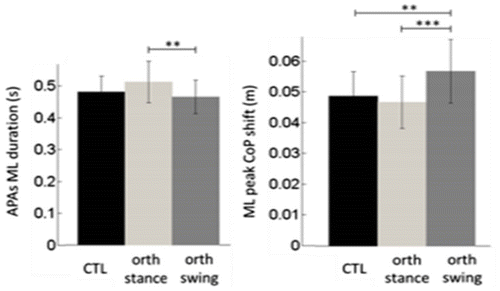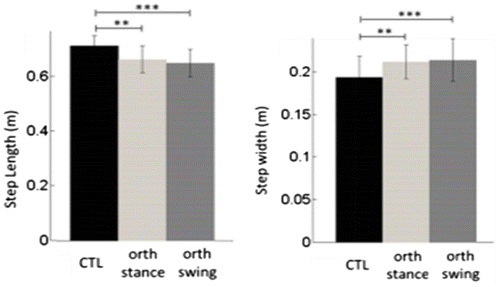1. Introduction
Gait initiation (GI) is the transient phase between quiet standing posture and ongoing walking (Brenière et al., Citation1987). GI can be divided into two phases: the ‘Anticipatory Postural Adjustments’ (APAs), followed by a step-execution phase ending. APAs are known to be predictive of motor performance (Brenière et al., Citation1987) and postural stability (Yiou et al., Citation2016) during GI.
The role of knee mobility during GI has received much less attention compared to hip and ankle (Delafontaine et al., Citation2015). Honeine et al. (Citation2016) reported that stance knee flexion during APAs could contribute to the anticipatory mediolateral COP shift and would thus be involved in the maintenance of postural stability.
Swing knee mobility is also involved in the maintenance of postural stability, due to the contribution of knee flexion at the end of APAs in clearing the swing foot from the ground and thus avoid stumbling. Swing knee mobility is also involved in GI performance, due to the contribution of knee extension in reaching the intended step length. Changes in stability and performance were observed in patients suffering from knee hypomobility or knee trembling (Jacobs et al., Citation2009).
However, it remains unclear whether the changes in GI process could be primarily ascribed to normal adaptation to knee hypomobility or to abnormal APAs programming due to impairment in the neural pathways/structures involved in the coordination between posture and movement.
The goal of the present study was to get further insight into the role of knee mobility on GI in able-bodied participants.
The effects of an experimentally-induced knee hypomobility by means of an orthosis placed over the stance- or swing-leg knee were investigated. It is hypothesized that stance- and swing-leg knee hypomobility will require adaptive changes in the balance control parameters of GI so as to maintain stability unchanged at the cost of reducing motor performance as compared to GI without orthosis.
2. Methods
2.1 Population, material and protocol
Twenty-seven healthy adults (Table ) performed series of gait initiation on a force-plate in the following conditions: without orthosis (‘control’), with knee orthosis over the swing leg (‘orth-swing’) and stance leg (‘orth-stance’). Subjects walked bare-footed at a self-paced speed. Within each knee orthosis condition the order of starting limb was randomly assigned. In the ‘orth-swing’ and ‘orth-stance’ conditions, the swing leg was considered to be that in which subjects always stepped to recover balance following a push from behind. Each experimental condition comprised 10 trials. The normality of data was checked using the Kolmogorov-Smirnov test and the homogeneity of variances was checked using the Bartlett test. One way repeated measures ANOVAs with the condition (‘control’, ‘orth-swing’, ‘orth-stance’) as within subject factor was used. A significant outcome was followed-up with the Tukey post hoc test.
Table 1. Characteristics of population.
2.2 Biomechanical parameters
During the APAs phase, anteroposterior and mediolateral displacement of center of pressure, duration and mediolateral stability were measured. During the step-execution phase, step length and width, duration of execution phase, swing leg’s vertical force impact at foot contact and progression velocity were examined.
3. Results and discussion
In orth-stance, mediolateral (ML) APAs duration was longer and ML COP shift lower than in orth-swing (Figure ).
Figure 1. Comparison of selected APAs parameters between the three conditions in the main experiment. Reported are mean values (all participants together) ± 1SD. ** and *** indicates a significant difference between bars with respectively p < 0.01 and p < 0.001.

In orth-swing, the amplitude of mediolateral APAs and step width (Figure ) were larger, execution phase duration longer and anteroposterior APAs smaller than in control.
Figure 2. Comparison of selected step execution parameters between the three conditions in the main experiment. Reported are mean values (all participants together) ± 1SD. ** and *** indicates a significant difference between bars with respectively p < 0.01 and p < 0.001.

As a consequence, step length (Figure ) and progression velocity were altered whereas stability was enhanced compared to control.
The vertical force impact at swing foot-contact did not change across conditions, despite a smaller step length in the orthosis conditions compared to control.
The application of a local mechanical constraint thus induced profound changes in the global organization of gait initiation, altering motor performance but ensuring greater stability.
It was proposed that the central nervous system (CNS) sets reference values for stability and vertical disturbance before stepping. The CNS would then plan the APAs features, step width and length so as to reach these desired reference values.
4. Conclusions
This study presents evidence that the application of a local mechanical constraint, herein induced by unilateral knee hypomobility, induced profound changes in the global organization of gait initiation, altering motor performance but ensuring greater stability. It was proposed that the CNS sets ‘global’ reference values before stepping, one for the mediolateral stability and one for the vertical disturbance at the time of swing foot collision with the ground. These reference values would be set based on an internal representation of the current state of the postural system, the task dynamics and its novelty. The CNS would then plan APAs features, step width and length so as to reach the desired reference values.
References
- Brenière Y, Do MC, Bouisset S. 1987. Are dynamic phenomena prior to stepping essential to walking? J Mot Behav. 19(1):62–76.10.1080/00222895.1987.10735400
- Delafontaine A, Honeine JL, Do MC, Gagey O, Chong RKY. 2015. Comparative gait initiation kinematics between simulated unilateral and bilateral ankle hypomobility: does bilateral constraint improve speed performance? Neurosci Lett. 603:55–59.10.1016/j.neulet.2015.07.016
- Honeine JL, Schieppati M, Crisafulli O, Do MC. 2016. The neuro-mechanical processes that underlie goal-directed medio-lateral APA during gait initiation. Front Hum Neurosci. 10, 445.
- Jacobs JV, Nutt JG, Carlson-Kuhta P, Stephens M, Horak FB. 2009. Knee trembling during freezing of gait represents multiple anticipatory postural adjustments. Exp Neurol. 215: 334–341.10.1016/j.expneurol.2008.10.019
- Yiou E, Artico R, Teyssedre CA, Labaune O, Fourcade P. 2016. Anticipatory postural control of stability during gait initiation over obstacles of different height and distance made under reaction-time and self-initiated instructions. Front Hum Neurosci. 10, 449.
